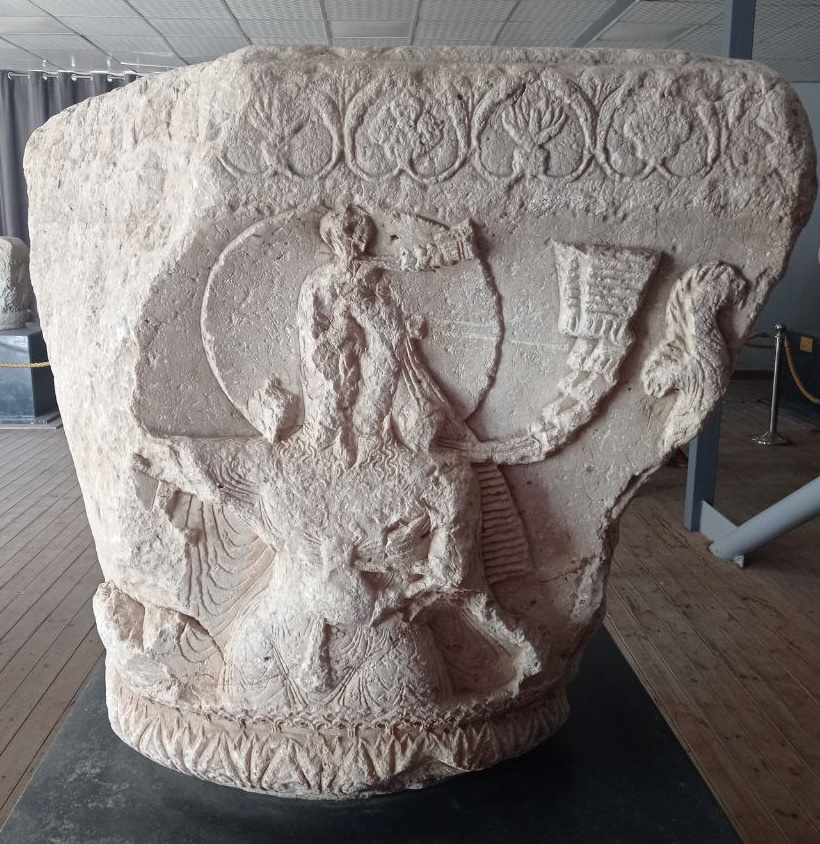Thread: Gold plaque depicting a naked goddess on a horse. According to imj.org.il/en/collections… probably Astarte or Anat. Late Canaan period, 13th c. BC, Found in Levant, but made under strong Egyptian influence.
What is the meaning of this image??? And who is the naked goddess?
What is the meaning of this image??? And who is the naked goddess?

Have you ever heard of the "Mother-of-Horses"? (jstor.org/stable/44088926) A goddess found in texts from Bronze Age Ugarit (en.wikipedia.org/wiki/Ugarit)?
Is this goddess standing on a horse the "Mother-of-Horses"?
Well, apparently, we still don't know if she was a goddess or "a symbolic entity representing a human’s concern for their horses"...
Well, apparently, we still don't know if she was a goddess or "a symbolic entity representing a human’s concern for their horses"...
Cause the mentions of the "Mother-of-Horses" were apparently found "primarily in incantations against snakebites"...What does horse goddess have to do with snakes?
Well, interestingly both Snakes and Horses are solar animals, Solar symbols...
Well, interestingly both Snakes and Horses are solar animals, Solar symbols...
And so I would here like to propose that the "Mother-of-Horses" was just an epithet...Epithet of whom? Of the alleged Mother of the "Mother-of-Horses": the sun goddess Shapash (en.wikipedia.org/wiki/Shapash), female equivalent of the sun god Shamash...
Snake is a pure solar animal. It is in our world when sun is here (day, hot half of the year) and it is in the underworld when sun is there (night, cold half of the year)...I talked about it in this post:
oldeuropeanculture.blogspot.com/2022/01/letnit…
oldeuropeanculture.blogspot.com/2022/01/letnit…

This is why snake is one of the oldest solar symbols found in Eurasia
https://twitter.com/serbiaireland/status/1494368413074006022
What about horses? The natural breeding season of horses typically begins around mid-April and finishes around mid September...It is marked by wild stallion fights for mares...
oldeuropeanculture.blogspot.com/2020/06/trojan…
oldeuropeanculture.blogspot.com/2020/09/unicor…
oldeuropeanculture.blogspot.com/2020/06/trojan…
oldeuropeanculture.blogspot.com/2020/09/unicor…

Horses sexual drive is governed by the sun and it peaks on summer solstice...I heard summer solstice was a big thing for sun worshipers...Hence horse twins marking the midsummer...
I talked about this here
I talked about this here
https://twitter.com/serbiaireland/status/1405588128681844737
It is not just horses whose mating season is governed by the sun. It's all the equids...Asiatic wild asses have the same mating season as wild horses, which also starts in Apr/May...I talked about this here oldeuropeanculture.blogspot.com/2020/11/onager… 

BTW Equine gestation period is 11-12 months...Which means that the equine mating season (Apr-Sep) is also the equine birthing season... 

And that season corresponds to hot dry half of the year in Middle East and Levant...Apr/May - Oct/Nov...The season dominated by the sun...
And the season which starts with the mating season of most common snakes in Eurasia, vipers...

And the season which starts with the mating season of most common snakes in Eurasia, vipers...


Hence the link between equids and snakes...
Remember this thread about how old is the symbolic link between equids and snakes?
Remember this thread about how old is the symbolic link between equids and snakes?
https://twitter.com/serbiaireland/status/1496565688953094147
So, I guess, if you knew that the sun god(dess), the one that controls the mating season of horses (hence The Mother of Horses) was the one that controls the appearance and disappearance of snakes, you would logically pray to her for protection from snakes...I guess...
But the guys from the Israel Museum, Jerusalem say it's "Astarte or Anat". Well, It is definitely not Anat...Anat is the one that kills Mot (the hot dry season, season of the horse), and helps Baal (the cool wet season) get the throne...oldeuropeanculture.blogspot.com/2021/08/anat.h… 

She could be Astarte, cause this lady is linked with the grain harvest and storage season, which overlaps with the horse mating season...
oldeuropeanculture.blogspot.com/2021/10/sacred…
oldeuropeanculture.blogspot.com/2022/02/jerusa…
oldeuropeanculture.blogspot.com/2021/10/tishtr…
oldeuropeanculture.blogspot.com/2021/10/sacred…
oldeuropeanculture.blogspot.com/2022/02/jerusa…
oldeuropeanculture.blogspot.com/2021/10/tishtr…

Now how can I be certain that the horse on our plaque is an animal calendar marker for the horse mating season? Because of what the goddess standing on the horse is holding in each hand: a papyrus and a lotus flower... 

And these are very important plant calendar markers...From Egypt...
The water level of the Nile starts to rise when the papyrus starts flowering (Apr/May/Jun...) and it peaks when lotus starts flowering (Jul/Aug/Sep), during the flood...
The water level of the Nile starts to rise when the papyrus starts flowering (Apr/May/Jun...) and it peaks when lotus starts flowering (Jul/Aug/Sep), during the flood...
https://twitter.com/serbiaireland/status/1420398664346914818
The flowering seasons of papyrus and lotus demarcate the flood season in Egypt (Apr-Oct), the fertile season...Which is also the fertile season of the horses (Apr-Sep)...
Hence the goddess on the horse holding papyrus and lotus flowers represents period Apr-Sep...
Hence the goddess on the horse holding papyrus and lotus flowers represents period Apr-Sep...

BTW, I just noticed something...The Papyrus - Lotus bunch often depicted on Egyptian wall paintings resembles Ankh, the symbol for Life...Life made possible in Egypt by the flood...
You might like this article... oldeuropeanculture.blogspot.com/2019/10/an-ki-…

You might like this article... oldeuropeanculture.blogspot.com/2019/10/an-ki-…


That's it...More about ancient animal and plant calendar markers, start here oldeuropeanculture.blogspot.com/p/animal-solar…… then check the rest of the blog posts I still didn't add to this page, and finally check my twitter threads I still didn't convert to blog post...I am 9 months behind now...
• • •
Missing some Tweet in this thread? You can try to
force a refresh























